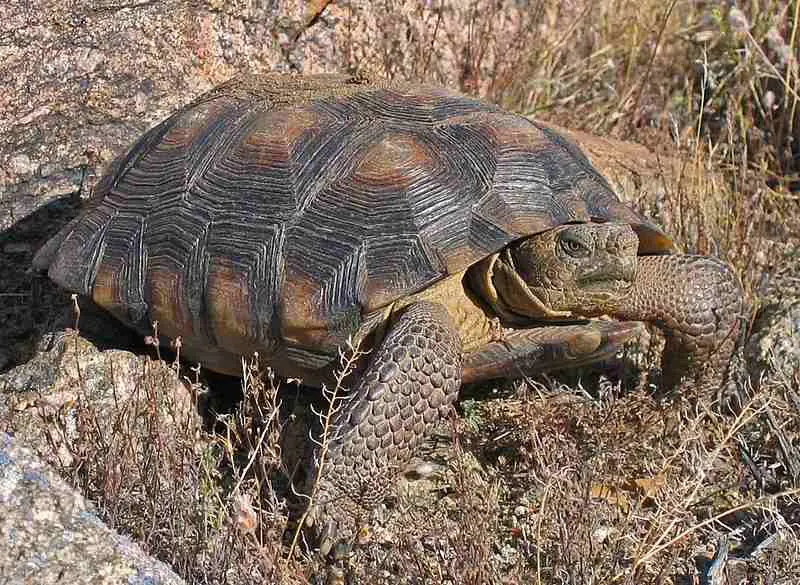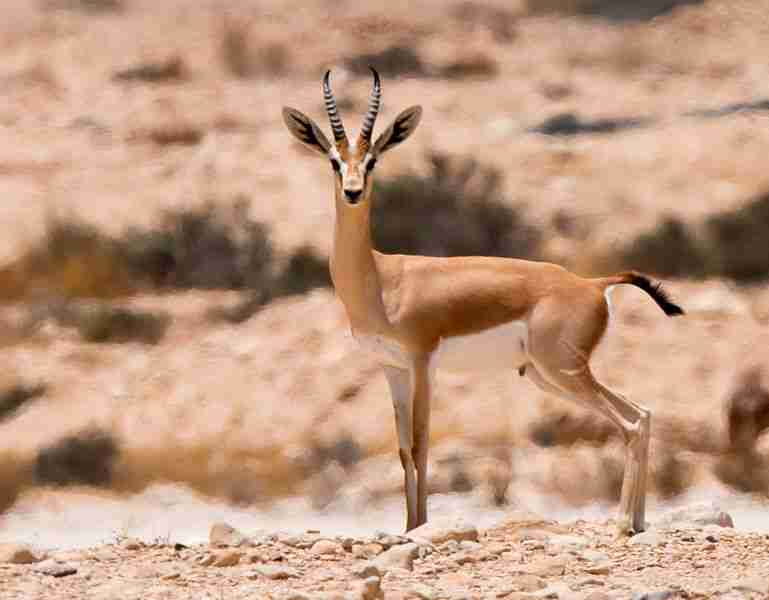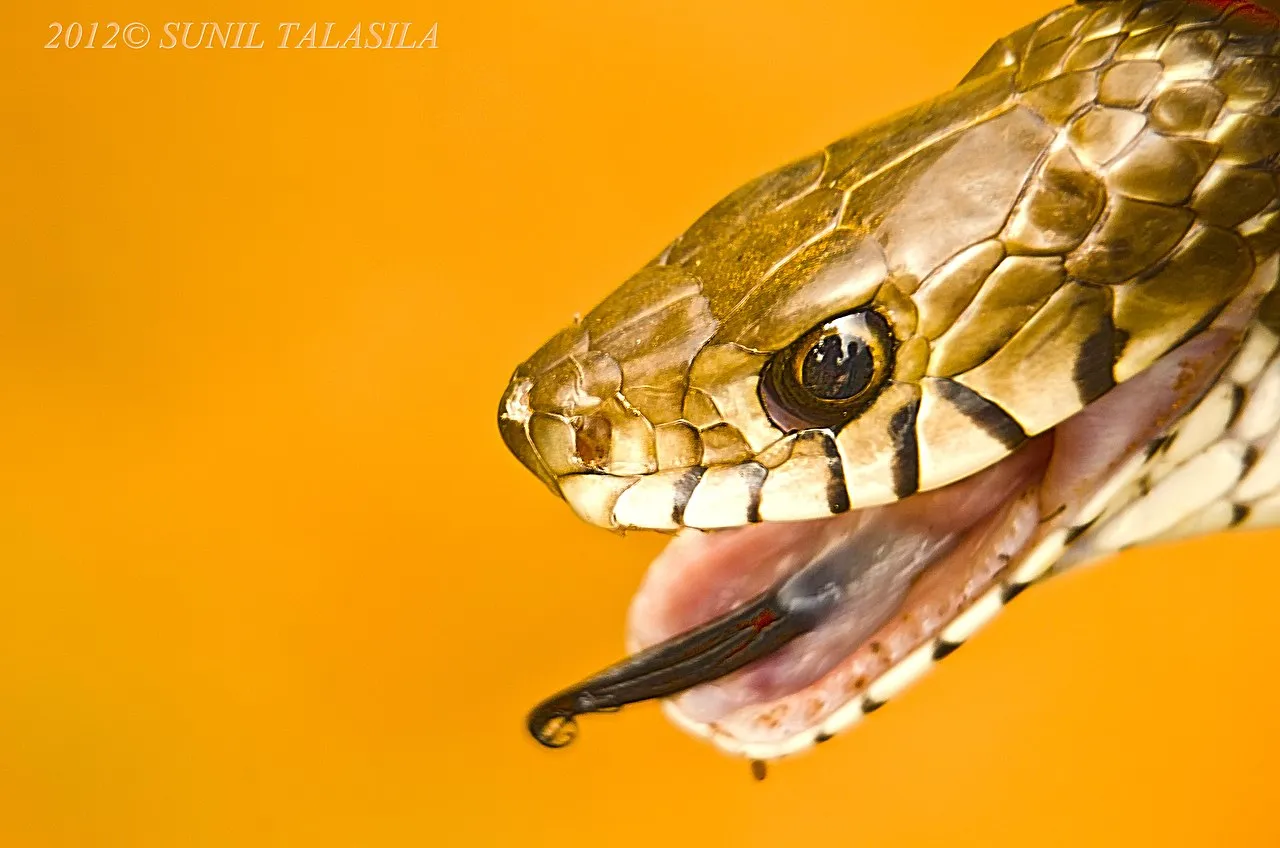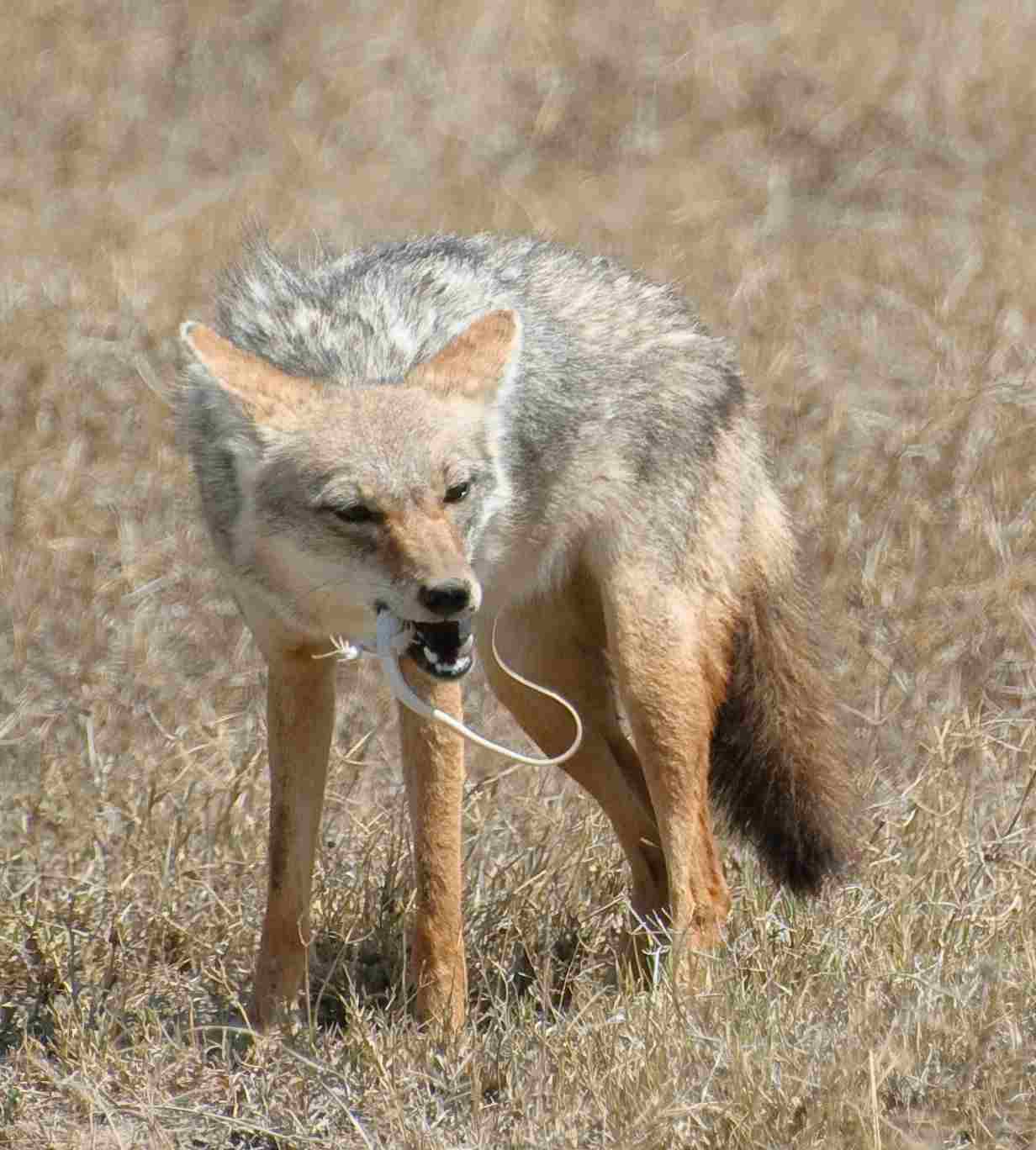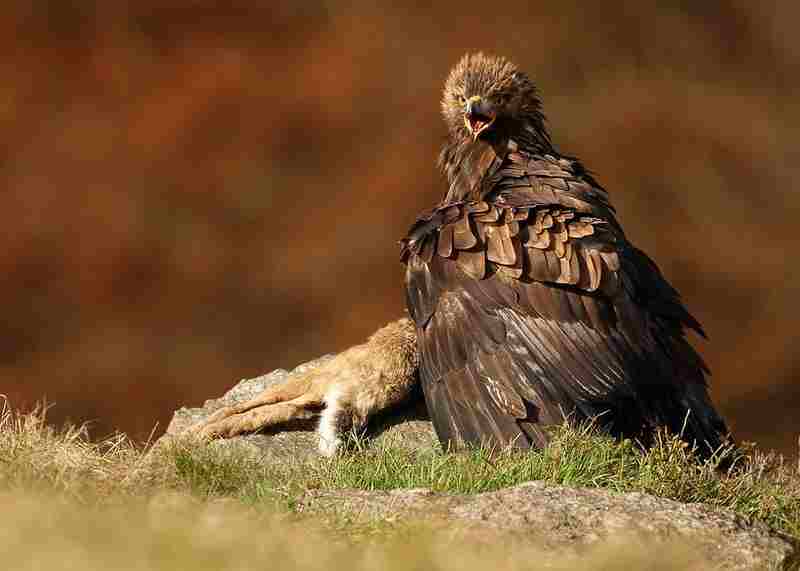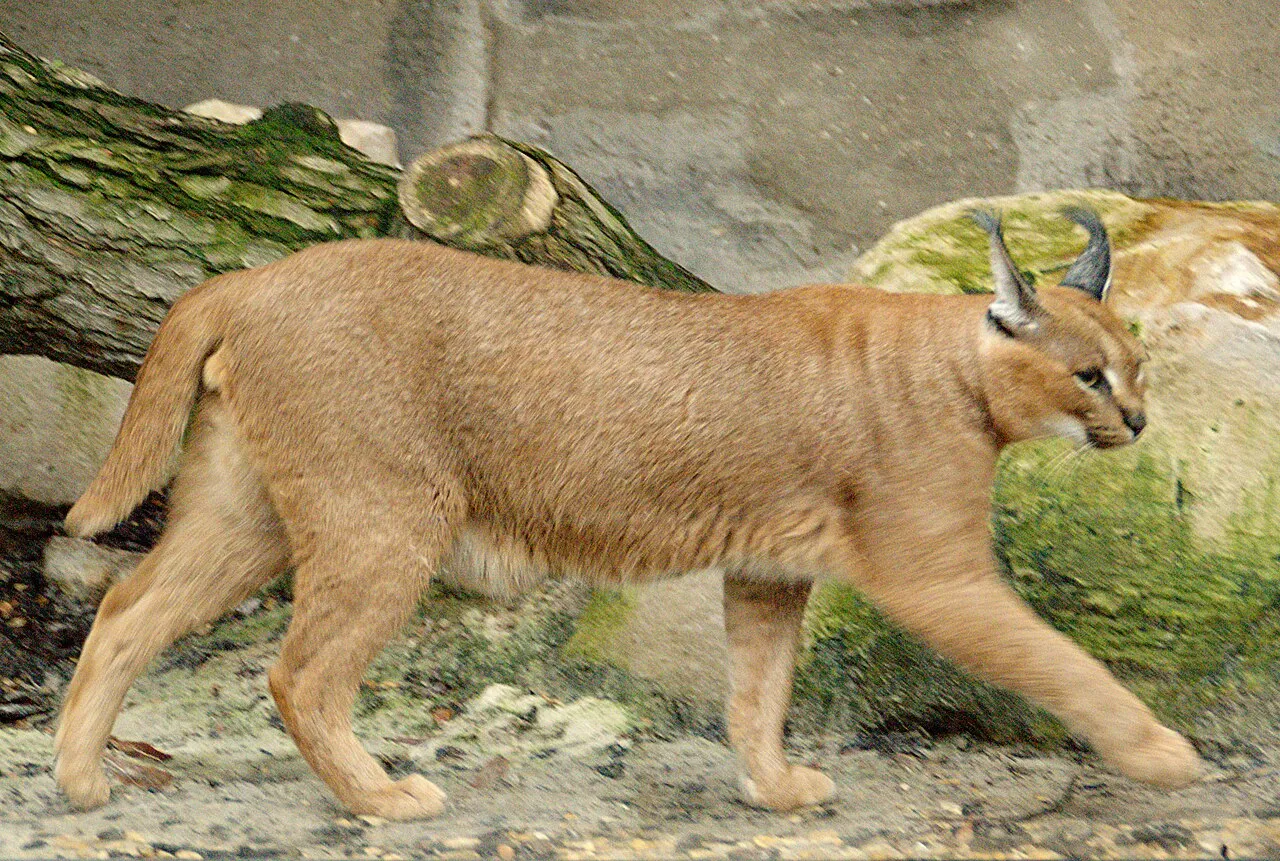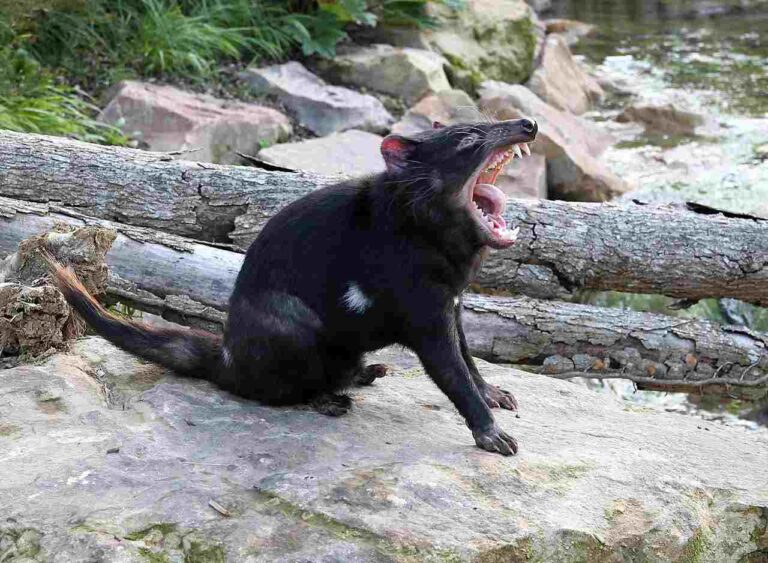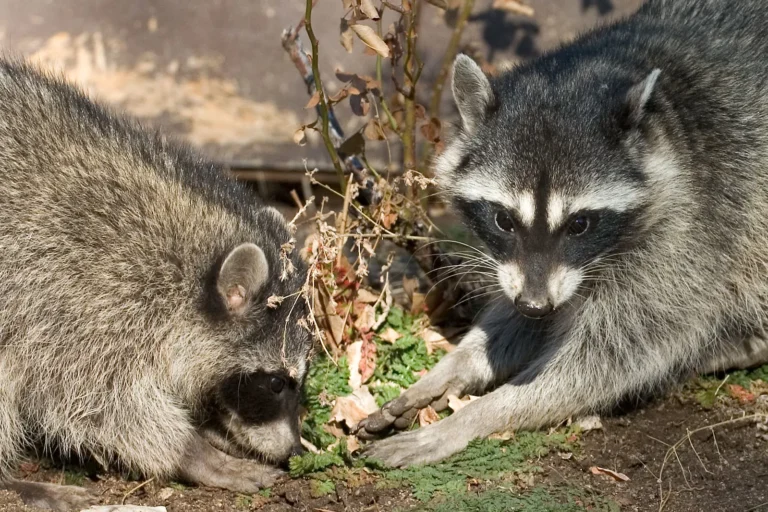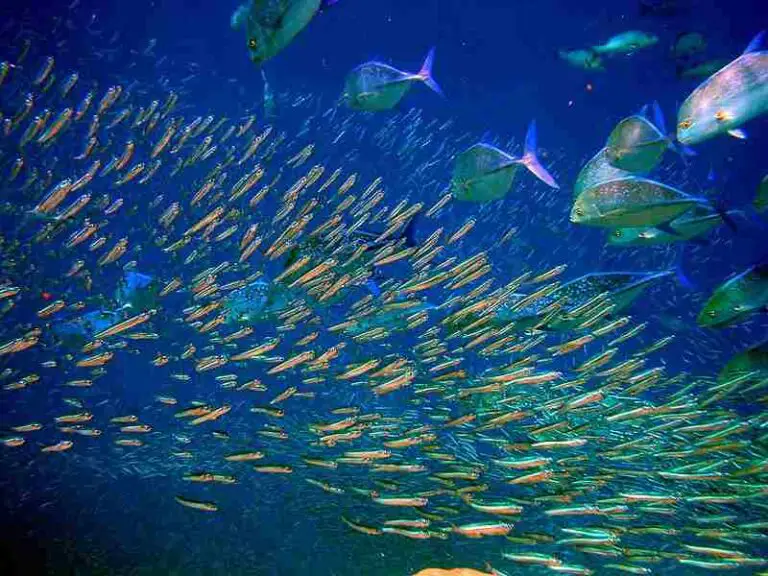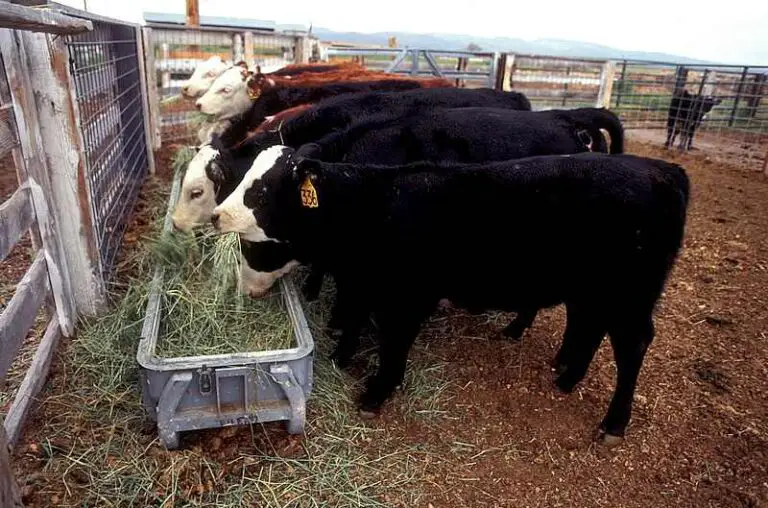Desert Food Chain with Five(5) Trophic Levels and Decomposers
Desert food chain consists of producers like creosote bush and cactus; primary consumers like desert tortoise and kangaroo rat; secondary consumers like hawk and fennec fox; tertiary consumers like caracal and African golden wolf; quaternary consumers like mulga snake and eagle; and decomposers like bacteria and fungi.
This article discusses the desert food chain with five trophic levels as well as decomposers, as follows;
1). Producers in the Desert (as part of the Desert Food Chain)
Producers in the desert are a group of autotrophic organisms that have the ability to capture and convert solar radiation (in the form of light) into biomass and chemical energy, through a process known as photosynthesis [17].
They are very critical for the sustenance of life in the desert ecosystem; because they are a primary source of nutrients and energy for organisms in all other trophic levels.
Multiple adaptive features have evolved in these producers, which enable them thrive under the harsh desert climate, and with limited supply of nutrients.
Main Groups of Producers in the Desert
The main groups or categories of producers in the desert are; succulents, grasses, shrubs and wildflowers. Each of these groups is discussed briefly below;
*Succulents as a Category of Producers in the Desert
Succulents; also called 'succulent plants'; are a group of desert plants which have specialized adaptations enabling them to store significant amounts of water in the dense tissues of these stems and/or leaves [1].
These plants are able to survive in harsh arid environments by utilizing stored water during the driest seasons/periods.
A classic and well-known example of a succulent desert plant is the cactus (plural cacti).
Cacti are equipped with thick, fleshy stems that store water [11].
They also have specialized, spiny leaves that also store water, and have spines for defense against herbivorous consumers.

*Grasses as a Category of Desert Producers
Desert grasses include needlegrass and buffalo grass; which have evolved to tolerate extreme heat, drought, and other typical desert conditions.
Most grasses in the desert possess well-developed fibrous root systems that can reach significant depths in the soil in order to access water [10].
They also tend to produce narrow leaves, whose small relative surface area reduces the rate of evapotranspiration and water loss.
There are multiple ecological functions of desert grasses; including (wind) erosion-mitigation, soil stabilization, and provision of forage for herbivores.
*Shrubs as a Category of Producers in the Desert
Examples of shrubs in the desert are mesquite and creosote bush.
These plants are adapted to water-shortage and low nutrient availability.
Desert shrubs have deep roots which help them access water at depth in the soil.
They also produce leaves that are small and hairy or waxy; an adaptation for the purpose of water conservation.
Like other desert producers, shrubs are a source of food and shelter for various organisms.
*Wildflowers as Producers in the Desert
Some flowering plants thrive in the desert in spite of limited rainfall.
Examples of desert wildflowers are sunflower and marigold; both of which tend to bloom after an event of rainfall.
Adaptive characteristics of wildflowers in the desert are; deep (tap) roots, small leaves, thick vascular tissues for water storage, efficient water-utilization, and brightly-colored flowers.
Their flowers attract various pollinators that play a role in the sustenance of these plants.
*Trophic Relations, Function(s) and Importance of Producers in the Desert Food Chain
Producers for the basal level of the desert food chain, by providing nutrients and energy for heterotrophic organisms in higher levels.
They are consumed by herbivorous primary consumers like desert tortoise and kangaroo rat; which rely on the producers as a major food source.
Predatory desert animals like raptors, carnivorous mammals, and snakes; in turn rely on herbivores for energy and nutrients.
This sequence of relations leads to continuous energy-transfer from producers to consumers.
*Examples of Producers in the Desert
Producers in the desert include;
1. Cactus
2. Yucca
3. Creosote bush
4. Marigold
5. Sunflower
6. Mesquite
7. Buffalo grass
8. Needlegrass
2). Primary Consumers in the Desert
Primary consumers in the desert are organisms with herbivorous feeding habits, that directly feed on producers (that is; desert plants) for their nutrients and energy.
They are vital in their role within the desert ecosystem, by serving as an energy-bridge between producers and non-herbivorous consumers in higher trophic levels.
Primary consumers in the desert are equipped with specialized adaptations for feeding on desert vegetation, and coping with the general harshness of their habitat.
Examples of Primary Consumers in the Desert Food Chain
Examples of primary consumers in the desert are; kangaroo rats, desert beetles, desert tortoises, and desert hares. Each is discussed briefly below;
*Kangaroo Rat as a Primary Consumer in the Desert
The kangaroo rat is a small rodent that occurs in desert regions like the Mojave [16].
It possesses adaptive characteristics for survival under conditions of water-scarcity; including efficient renal (kidney) system for reabsorption and utilization of water in ingested food materials.
The diet of kangaroo rats consists of seeds, and they have the habit of storing or caching such seeds in burrows for subsequent consumption [8].
Activities of kangaroo rats are essential to the dispersal of seeds and regeneration of plants in the desert.
*Desert Beetles as Primary Consumers
Not all desert beetles are strictly herbivorous.
Rather, most of them have omnivorous and detrivorous feeding habits, that contribute to biodegradation and nutrient-cycling in their habitat.
However, plant matter forms a significant portion of the diet, of most desert beetles, including tenebrionid beetles.
Like other desert consumers, these beetles have developed adaptive traits that help them absorb moisture in food, and minimize water loss.
Desert beetles may obtain plant materials in the form of litter or decaying remains. They may also feed on the parts of living plants.
In turn, they serve as a source of food for some higher organisms, including secondary consumers like reptiles.
*Tortoise as a Primary Consumer in the Desert
Tortoises are reptiles with herbivorous habits, and some species are adapted to arid conditions.
These species are desert tortoises, which possess specialized mouthparts and digestive tracts for feeding on fibrous and succulent plants like desert grasses, shrubs and cacti.
Desert tortoises also obtain water from plants which they have consumed. They are vital to the dispersal of seeds in the desert.

*Desert Hare as a Primary Consumer
Desert hares like the cottontail and black-tailed jackrabbit [16], are effective primary consumers.
Their features include powerful hind limbs for swift movement in search of food and to elude predators.
Food for the desert hare comprises of plant matter from succulents, shrubs and grasses.
Through feeding, they contribute to the regulation of plant growth rate; which is essential for conservation of soil nutrients. They also are crucial for nutrient cycling and overall ecologic balance.
Trophic Relationships Involving Primary Consumers in the Desert Food Chain
Primary consumers occupy the second trophic level in the desert food chain; and obtain their nutrients and energy from plants which they feed on.
The desert primary consumers control plant growth rate in their habitat; and have a direct influence on the spatial distribution, as well as density; of desert vegetation.
In addition to these, they are food sources for higher organisms like secondary and tertiary consumers.
An Outline of Examples of Primary Consumers in the Desert
Examples of primary consumers in the desert are;
1. Desert hare
2. Desert tortoise
3. Kangaroo rat
4. Desert beetle(s)
5. Dromedary camel
6. Desert gerbil
7. Dorcas gazelle
3). Secondary Consumers in the Desert (as part of the Desert Food Chain)
Secondary consumers in the desert are carnivorous animals which feed mainly on primary consumers or herbivores.
They are found in the third trophic level of the food chain, and are vital in their role of regulating the population sizes of organisms which they prey upon; thereby helping to maintain ecological balance.
Desert secondary consumers possess adaptive features which enable them capture and consume prey in their habitat.
Examples of Secondary Consumers in the Desert
Some secondary consumers in the desert are; foxes, snakes, and hawks.
*Foxes as Desert Secondary Consumers
Foxes in the desert include the sand fox and fennec fox [7].
These animals are well-adapted to the desert; having various physiological and behavioral features that enable them survive and thrive.
Their adaptive physiological features include low body fat to reduce heat accumulation, large ears for heat dissipation [13], and relatively small size for water and energy conservation.
They also posses keen sensitivity to locate prey, and exhibit behaviors like burrowing, which help them avoid direct exposure to harsh conditions; and to elude larger predators.
Food for desert foxes includes birds, reptiles and small mammals like rodents.
They play a role in the regulation of prey populations, which in turn prevents overgrazing and influences the density and distribution of desert plants.
*Snakes as Secondary Consumers in the Desert Food Chain
Snakes in the desert include rattlesnake, sand boa and horned viper; all of which can be classified as secondary consumers.
They have adaptations like camouflage and heat-detectability; which they use to capture prey and elude potential predators.
Desert snakes feed on other reptiles, as well as birds and small mammals. Their presence us vital for the sustainability of the desert biome.
*Hawks as Secondary Consumers in the Desert
Hawks in the desert include peregrine falcon and lanner falcon.
They are important predators that utilize aerial navigation and keen sensitivity to their advantage while hunting.
The exceptional flight and eyesight of hawks enable them detect and capture prey.
Animals which hawks prey upon in the desert include rodents and smaller birds; whose populations are influenced by the activities of these raptors.
*Outline of Examples of Secondary Consumers in the Desert
Examples of secondary consumers in the desert are;
1. Foxes
2. Rattlesnake
3. Hawks
4. Desert monitor lizard
5. Coyote
6. Owl
7. Sand boa
8. Horned viper
4). Tertiary Consumers in the Desert
Tertiary consumers in the desert are highly-placed predators that occupy trophic level 4 of the food chain.
These animals prey on other consumers, including primary and secondary groups. They are crucial to the maintenance of ecologic balance in their habitat, through regulation of organic populations in lower trophic levels, and contribution to bioenergy flow.
Tertiary desert consumers have adaptations that enable them efficiently capture and consume prey.
Examples of Tertiary Consumers in the Desert Food Chain
Examples of tertiary consumers in the desert are; desert lynx, African golden wolf, and lappet-faced vulture.
*Lynx as a Tertiary Consumer in the Desert
The desert lynx is also called the caracal, and inhabits arid regions like the marginal zones of the Sahara [4].
Its features include tufted ears for enhanced hearing and prey location.
Food for the desert lynx includes herbivorous rodents and birds. Like other predators, it has significant influence on the population-dynamics of these organisms.

*African Golden Wolf as a Tertiary Consumer in the Desert
The African golden wolf or golden jackal, is a canid with predatory characteristics, that occurs in the Sahara desert.
Its attributes include agility and resilience, and its prey ranges from a variety of mammalian organisms to reptiles, insects and birds.
African golden wolves help maintain the balance of desert ecosystems by regulating prey populations.
*Lappet-Faced Vulture as a Tertiary Consumer in the Desert
The lappet-faced vulture is a large and powerful bird that is classified as a tertiary consumer because its scavenging habit enables it feed on organisms from any trophic level of the food chain.
Lappet-faced vultures play a crucial role in nutrient-cycling and pathogen reduction; by consuming animal remains and carrion in the desert.
They are equipped with a keen sense of smell [5] that allows them locate food from significant distances. As earlier stated, their scavenging activities reduce the spread of pathogens and diseases, and facilitate the recycling of nutrients.
Trophic Relationships Involving Tertiary Consumers in the Desert
Tertiary consumers occupy the fourth trophic level of the desert food chain, and in the absence of quaternary consumer, may function as apex predators.
They are capable of feeding on primary and secondary consumers; and help regulate the populations of these groups.
The ripple effect of this is top-down control over the ecologic dynamics in lower trophic levels; a phenomenon otherwise described as trophic cascade effect [14].
Tertiary consumers also influence some trends in the adaptation of desert organisms, thereby playing a role in the instantaneous state of species richness and diversity.
5). Quaternary Consumers in the Desert (as part of the Desert Food Chain)
Quaternary consumers are organisms whose characteristics place them at the absolute apex level or top of the food chain in the desert ecosystem.
They feed on tertiary consumers, alongside primary and secondary consumers.
Due to their position in the ecosystem, quaternary consumers exert a strong influence over the populations and adaptations of organisms in lower trophic levels. This influence contributes to the sustenance of ecologic balance in the desert.
Examples of Quaternary Consumers in the Desert
Examples of quaternary consumers in the desert are; bobcat, mulga snake, and eagle. Each of them is briefly discussed below;
*Bobcat as a Quaternary Consumer in the Desert Food Chain
Bobcat (Lynx rufus) is a medium-sized feline with carnivorous feeding habits; that inhabits arid and semiarid zones.
Its adaptations include retractable claws, acute hearing capabilities, and keen sight.
Bobcats prey on birds, reptiles and small mammals, and are often nocturnally active.
They contribute to ecological functionality and stability through their feeding activities.
*Mulga Snake
Also known as the king brown snake; mulga snake is classified as a quaternary consumer due to its superior size and venomous potency, compared to other snakes in the desert.
Mulga snakes can grow up to 3 meters long [6], and weigh up to 6 kilograms. They are mostly found in Australian arid and semiarid areas.

*Eagle as a Quaternary Consumer in the Desert
Eagles may traverse the desert in search of prey, thereby becoming a part of the desert food chain. These include some species of bald eagles, as well as the golden eagle (Aquila chrysaetos).
Because eagles are larger and more powerful than hawks and other desert raptors, they can be placed above these counterparts as quaternary consumers in the trophic hierarchy.
Features of eagles that support their predatory role include excellent eyesight, sharp beak, and powerful talons.
In the desert, eagles may prey on small mammals, other birds, and reptiles. They influence the populations and adaptations of these prey animals, and contribute to ecological balance of the desert.
Trophic Relationships and Effects Involving Quaternary Consumers in the Desert
Quaternary consumers help regulate the overall balance of the desert food web; by impacting the populations of organisms beneath them in the trophic hierarchy.
Through their effect on direct prey; quaternary consumers contribute to the trophic cascade phenomenon; and ensure that there is a state of balance in energy flow between trophic levels.
They help prevent overpopulation and promote biodiversity by controlling prey densities and facilitating evolutionary/adaptive developments in these prey.
6). Decomposers in the Desert
Decomposers are vital to the desert ecosystem as a result of their role in the breakdown of organic matter, and the recycling of used nutrients back into the food chain.
As their name implies, these organisms are responsible for facilitating the process of decomposition; which is essential to maintain nutrient availability and soil fertility (or at least the ability of the soil to support plant growth).
Decomposers do not occupy a distinct trophic level of their own, but operate in all trophic levels where organic matter occurs.
They are also less prominent than consumers and producers; yet crucial for the sustainability and overall functioning of the ecosystem.
In the section below, Sahara desert is used as a reference point for further discussion on decomposers in arid environments.
Examples of Decomposers in the Sahara Desert
Examples of decomposers in the desert are; fungi, bacteria, and detrivorous insects. Vultures can also be classified as decomposers in some cases.
Each of these examples is discussed briefly below;
*Fungi as Decomposers in the Desert Food Chain
Fungi are a group of microscopic decomposers that can be found in the Sahara desert [12], as well as in other arid zones.
They are critical toward the decomposition of plant and animal remains, as well as organic waste materials.
Fungi are equipped with specialized structures known as hyphae, which enable them penetrate and degrade organic matter [3]. They also secrete enzymes which facilitate the breakdown process and transform complex organic molecules to simpler products that can be assimilated by soil, and subsequently absorbed by other desert organisms.
Fungi play a key role in the recycling of nutrients, thereby contributing to conservation of soil in arid regions.
*Bacteria as Decomposers in the Sahara Desert
Bacteria represent another group of microscopic decomposers that occur in desert soils [2].
They are important for the breakdown of organic matter to form simpler products in the process of biodegradation.
Bacteria are known to possess adaptive features that help them in their role; such as drought-tolerance and versatility of substrate.
Through their activities, these microbes contribute to nutrient cycling, through the release of nutrients from decomposing organic matter into the soil.
*Detrivorous Insects as Decomposers in the Desert
Some insects feed on organic litter or detritus in the desert, and thereby facilitate decomposition of such organic materials.
These insects are detrivores, and include termites which act as decomposers and pests, in regions on the edge of the Sahara desert [9].
Substrate for detrivorous desert insects comprises of leaf litter, animal waste, and other forms of organic matter.
The insects work together with microbes like gut bacteria, that aid in the breakdown of complex organic compounds like cellulose.
Digestion and decomposition of organic litter by detrivorous insects also release nutrients back into the soil from where they can be taken up and recycled.
Asides termites, other detrivorous insects that operate in the desert include flies, ants and beetles.

*Vultures as Decomposers in the Desert
As earlier stated, vultures can also be classified as decomposers in the desert, although it is also correct to consider them tertiary consumers in other contexts.
The reason for this is that vultures facilitate the breakdown of organic matter and recycling of used nutrients, through their scavenging.
They possess efficient digestive systems that are capable of breaking down carrion and eliminating pathogens in such organic matter. This is beneficial to the ecosystem because it reduces the risk and rate of pathogenic disease incidence, among organisms.
Trophic Relationships Involving Decomposers in the Desert
Decomposers occur throughout the desert food chain, and are arguably the most important group of organisms with regards to nutrient cycling.
They cause used nutrients in biomass to be released back into the environment through their activities; and these released nutrients may then be taken up by primary producers.
These decomposers (including fungi, bacteria and detrivorous insects) therefore may be described as natural recyclers of ecologic resources because they convert complex organic compounds to simpler products.
They play roles in soil conservation and overall functionality of the desert biome.
In summary, decomposers in the Sahara desert are;
1. Fungi
2. Bacteria
3. Termites
4. Ants
5. Flies
6. Vulture
Conclusion
The desert food chain comprises of;
1. Producers like cactus and creosote bush
2. Primary consumers like desert tortoise and kangaroo rat
3. Secondary consumers like fennec fox and hawk
4. Tertiary consumers like caracal, and African golden wolf
5. Quaternary consumers like mulga snake and eagle
6. Decomposers like bacteria, fungi, and detrivorous insects
Below are some hypothetical, multi-organic and multi-geographical desert food chains whose components have been derived mostly from this article. The chains below can be used for the construction of desert food webs;
Food Chain 1: Yucca, marigold, buffalo grass (Trophic Level 1)→black-tailed jackrabbit, desert locust, kangaroo rat (Trophic Level 2)→fennec fox, hawk, caracal (Trophic Level 3)→eagle (Trophic Level 5)
Food Chain 2: Creosote bush, cactus, sunflower, needlegrass (Trophic Level 1)→desert tortoise, Dorcas gazelle, desert gerbil (Trophic Level 2)→horned viper, owl, hawk (Trophic Level 3)→African golden wolf, lappet-faced vulture, bacteria (Trophic Level 4)
Food Chain 3: Marigold, yucca, mesquite, buffalo.grass (Trophic Level 1)→black-tailed jackrabbit, dromedary camel, desert gerbil (Trophic Level 2)→sand boa, desert monitor lizard, owl (Trophic Level 3)→caracal, eagle (Trophic Level 4)
Food Chain 4: Needlegrass, creosote bush, sunflower (Trophic Level 1)→desert locust, desert gerbil (Trophic Level 2)→hawk, rattlesnake, coyote (Trophic Level 3)→bobcat, golden eagle
Food Chain 5: Acacia, mesquite, buffalo grass, marigold (Trophic Level 1)→Dorcas gazelle, dromedary camel, desert tortoise, jackrabbit (Trophic Level 2)→sand fox, hawk, sand boa (Trophic Level 3)→mulga snake, caracal, lappet-faced vulture
References
1). Andrew, J.; Smith, C.; Nobel, P. S. (1986). "Water Movement and Storage in a Desert Succulent: Anatomy and Rehydration Kinetics for Leaves of Agave deserti." Journal of Experimental Botany, Volume 37, Issue 7, July 1986, Pages 1044–1053, Available at: https://doi.org/10.1093/jxb/37.7.1044. (Accessed 5 July 2023).
2). Bhatnagar, A.; Bhatnagar, M. (2005). "Microbial diversity in desert ecosystems." Current Science 89(1):91-100. Available at: https://www.academia.edu/2768654/Microbial_diversity_in_desert_ecosystems. (Accessed 5 July 2023).
3). Brand, A.C.; Gow; N. (2009). "Mechanisms of hypha orientation of fungi." Current Opinion in Microbiology 12(4):350-7. Available at: https://doi.org/10.1016/j.mib.2009.05.007. (Accessed 5 July 2023).
4). Dobamo, T. (2019). "Ecology of Caracals and Their Distribution in Africa: A Review Paper." Journal of Biology, Agriculture and Healthcare, Vol 9, No 13 (2019). Available at: https://doi.org/10.7176/JBAH/9-13-05. (Accessed 5 July 2023).
5). Downs, C. T.; Mangele, N. S.; Selier, J.; Taylor, J. (2023). "Vulture perceptions in a socio-ecological system: A case study of three protected areas in KwaZulu-Natal, South Africa." Journal of Ornithology. Available at: https://doi.org/10.1007/s10336-023-02075-7. (Accessed 5 July 2023).
6). Kuch; U.; Keogh, J. S.; Weigel, J.; Smith, L. A.; Mebs, D. (2005). "Phylogeography of Australia's king brown snake (Pseudechis australis) reveals Pliocene divergence and Pleistocene dispersal of a top predator." The Science of Nature 92(3):121-7. Available at: https://doi.org/10.1007/s00114-004-0602-0. (Accessed July 2023).
7). Larivière, S.; Seddon, P. J. (2001). "Vulpes rueppelli." Mammalian Species 678(678):1-5. Available at: https://doi.org/10.2307/3504505. (Accessed 5 July 2023).
8). Murray, A. L.; Barber, A. M.; Jenkins, S. H.; Longland, W. S. (2006). "Competitive Environment Affects Food-Hoarding Behavior of Merriam's Kangaroo Rats (Dipodomys merriami)." Journal of Mammalogy 87(3). Available at: https://doi.org/10.1644/05-MAMM-A-172R1.1. (Accessed 5 July 2023).
9). Najjari, A.; Taheri, A.; Hernández-Teixidor, D., Wetterer, J. K. (2023). "First outdoor records in the Old World of the invasive drywood termite, Cryptotermes brevis (Walker, 1853) (Kalotermitidae)." Journal of Applied Entomology. Available at: https://doi.org/10.1111/jen.13156. (Accessed 5 July 2023).
10). Namozov, N.; Saidova; M.; Urmanova, M.; Burxanova, D.; Rasulov, X.; Tursinbayev, M. (2022). "Effective methods of preventing degradation of desert pasture soils of Uzbekistan." IOP Conference Series: Earth and Environmental Science, Volume 1068, Sustainable Management of Earth Resources and Biodiversity. Available at: https://doi.org/10.1088/1755-1315/1068/1/012035. (Accessed 5 July 2023).
11). Nobel, P. S. (2006). "Parenchyma-chlorenchyma water movement during drought for the hemiepiphytic cactus Hylocereus undatus." Ann Bot. 2006 Mar;97(3):469-74. Available at: https://doi.org/10.1093/aob/mcj054. (Accessed 5 July 2023).
12). Ramirez-Canejo, L. A.; Zuluaga-Montero, A.; Morris, V.; Rodriguez, J. A.; Lázaro-Escudero, M. T.; Bayman, P. (2022). "Fungal diversity in Sahara dust: Aspergillus sydowii and other opportunistic pathogens." Springer, Aerobiologia 38(79). Available at: https://doi.org/10.1007/s10453-022-09752-9. (Accessed 5 July 2023).
13). Rocha, J. L.; Godinho, R.; Brito, J. C.; Nielsen, R. (2021). "Life in Deserts: The Genetic Basis of Mammalian Desert Adaptation." Trends Ecol Evol. 2021 Jul;36(7):637-650. Available at: https://doi.org/10.1016/j.tree.2021.03.007. (Accessed 5 July 2023).
14). Schmitz, O. J.; Hambäck, P.; Beckerman, A. P. (2000). "Trophic Cascades in Terrestrial Systems: A Review of the Effects of Carnivore Removals on Plants." The American Naturalist 155(2):141-153. Available at: https://doi.org/10.1086/303311. (Accessed 5 July 2023).
15). Simes, M. T.; Longshore, K. M.; Nussear, K. E.; Beatty, G.; Brown, D.; Esque, T. C. (2015). "Black-Tailed and White-Tailed Jackrabbits in the American West: History, Ecology, Ecological Significance, and Survey Methods." Western North American Naturalist 75(4):491-519. Available at: https://doi.org/10.3398/064.075.0406. (Accessed 5 July 2023).
16). Soholt, L. F. (1973). "Consumption of Primary Production by a Population of Kangaroo Rats (Dipodomys Merriami) in the Mojave Desert." Monographs, Volume 43, Issue 3 p. 357-376. Available at: https://doi.org/https://doi.org/10.2307/1942346. (Accessed 5 July 2023).
17). Zhou, Z.; Su, P.; Wu, X.; Zhang, H.; Shi, R.; Yang, J. (2022). "Leaf and canopy photosynthesis of four desert plants: considering different photosynthetic organs." Photosynth Res. 2022 Mar;151(3):265-277. Available at: https://doi.org/0.1007/s11120-021-00884-6. (Accessed 5 July 2023).
